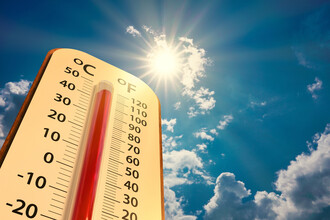Staying cool in extreme heat

Did you know the Sturgeon region is one of the 10 hottest regions in Alberta?
This means we’re more likely to experience extreme heat, where temperatures reach at least 29 C during the day and 14 C at night for at least two days in a row.
Even if you love the warn weather, extreme heat can cause serious health impacts, including dehydration, heat exhaustion, heat stroke and possibly death. These impacts are more likely to impact the following groups:
- older adults (60+)
- infants and young children
- people who are pregnant
- people with pre-existing medical and mental health conditions
- outdoor workers
- people with reduced mobility
- people who live alone or are socially isolated
- people who live in high-density housing with no indoor cooling
- people with unstable housing
Before an extreme heat event
Being prepared for extreme heat events means you have a plan and the supplies to stay cool, hydrated and informed.
- Build an emergency kit.
- Make a household emergency plan.
- Get the latest weather advisories from Environment Canada; download the WeatherCAN app from the Apple Store or Google Play store.
- If you live alone, see if a friend, family member or neighbour can check in with you during an extreme heat event.
- Keep plenty of food, cool drinks and your medication on hand so you can limit going out during extreme heat events.
- Make ice and keep jugs of cool water in your fridge.
- Fill up your vehicle fuel tank in case you need to drive to a cooler place.
- Put up curtains, blinds or awnings on your windows to keep the heat out. You can also cover windows with cardboard.
- If possible, purchase fans and spray bottles to keep yourself cool. Consider installing a window air conditioner in at least one room. Make sure air-conditioners and fans are working well.
- If you don’t have an air conditioner, make a list of nearby places with air-conditioning, like shopping malls, libraries, swimming pools, community centres and places of worship.
During an extreme heat event
- Stay hydrated. Drink plenty of water before you feel thirsty and eat hydrating foods such as fruits and fresh vegetables. Avoid sugary, caffeinated and alcoholic drinks as they cause dehydration.
- Stay cool indoors.
- Identify cooler areas in your home, such as a basement, or one room that can be kept cool. Consider using that space to sleep.
- If your home is too warm, consider leaving to stay with friends or family, or looking for public spaces with indoor cooling.
- Prepare meals that don’t need to be heated.
- Take cool showers or baths.
- Schedule outdoor activities carefully.
- Avoid direct sun and rest often in shady areas. Lower your activity level and avoid strenuous activity during high heat.
- Wear light-coloured, loose-fitting clothing that covers the skin, UV-protective sunglasses and a wide-brimmed hat.
- Use sunscreen of SPF 30 or higher.
- Never leave people or pets alone in a vehicle or in direct sunlight.
- Check-in on family, friends and neighbours who are at a higher risk of heat illness or live alone.
Signs of heat-related illness to watch for
Keep an eye on yourself and others for any of the following symptoms, and call 911 if you have signs of heatstroke:
- High body temperature (above 39.4 C)
- Lack of sweat
- Nausea
- Confusion and lack of coordination
- Dizziness, fainting or unconsciousness
Leave A Comment